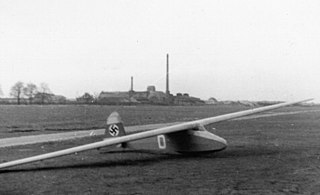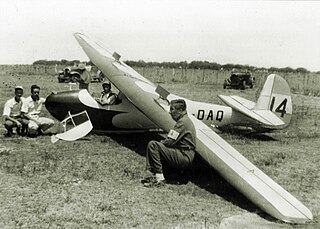
Edmund Schneider (26 July 1901 - 5 July 1968) was a German aircraft designer and owner of a glider factory. [1] [2]

Edmund Schneider (26 July 1901 - 5 July 1968) was a German aircraft designer and owner of a glider factory. [1] [2]
Schnieder was born in Ravensburg on 26 July 1902 and completed an apprenticeship in Memmingen as a carpenter. Towards the end of the First World War he applied to the German air force but was found unfit to fly. He found employment as a carpenter in the Schleissheim aircraft hangar, where military aircraft were repaired. He was able to study the design of fighter aircraft such as the Pfalz Albatros Flugzeugwerke, LFG, Fokker and Junkers.
At end of the war he moved to the Wasserkuppe mountain gliding site in the spring of 1923.. He met Gottlob Espenlaub and helped him with the completion of gliders he designed with Alexander Lippischa for the Rhön competition in the summer of 1923.
In autumn 1923 he went together with Espenlaub at the invitation of a local group of the German Flying club to Grunau near Hirschberg Silesia (now Poland). In the winter in Grunau, the construction of an easy-to-build and easy-to-fly, stable training glider was developed, which after a few modifications finally led to the Espenlaub-Schneider ESG-9 - a basic training glider. While Espenlaub later went to Kassel, Schneider settled down in Grunau and started his own business in 1928 with the Segelflugzeugbau Edmund Schneider. His most famous construction was the Schneider Grunau Baby. By about 1931 some 3000 examples had been produced by his company in Grunau.
In addition to the company's own aircraft, the gliders Wiesenbaude 1 and Wiesenbaude 2 were also commissioned for Eugen Bönsch, and the fuselage of the Moazagotl by Schneider ESG 31 Schlesierland for Eugen Bönsch who during 1931–1932 was principal of the Grunau gliding school.
Due to the increasing demand from the National Socialist Flyers Corps, Schneider employed more than 350 people in two plants when war broke out in 1939. At the end of World War II, Schneider left his business and fled with his family to Mühlhofen on Lake Constance.
The result was the draft ES-49, design, of which a copy has been preserved on the Wasserkuppe. The Schneider family emigrated to Australia in 1951 at the invitation of the Adelaide Aero Club in which city he established the Edmund Schneider Pty Ltd. [3] Other well-known gliders such as the Schneider ES-52 Kookaburra and the Schneider ES-60 Boomerang were built in Australia at Schneider's new factory in Adelaide. A licensed version of the Schleicher Ka 6 was also built in Australia.
Schneider died on 5 July 1968 in Rottach-Egern in Germany aged 67.

The Wasserkuppe is a mountain within the German state of Hesse. It is a large plateau formation at an elevation of 950 metres (3,120 ft) and is the highest peak in the Rhön Mountains. Great advances in sailplane development took place on the mountain during the interwar period, driven by annual contests. Near the summit there is still an airfield used by gliding clubs and pilots of light aircraft.

Squadron Leader Robert Kronfeld, AFC was an Austrian-born gliding champion and sailplane designer of the 1920s and 30s. He became a British subject and an RAF test pilot. He was killed testing a glider in 1948.

Wolfram Kurt Erhard Hirth was a German gliding pioneer and sailplane designer. He was a co-founder of Schempp-Hirth, still a renowned glider manufacturer.
The Rhön-Rossitten Gesellschaft (RRG) or Rhön-Rossitten Society was a German gliding organization, the first one in the world that was officially recognised. The Rhön-Rossitten Gesellschaft was mainly responsible for establishing gliding as a sport, not only in Germany but eventually throughout the world.

Hang gliding is an air sport employing a foot-launchable aircraft. Typically, a modern hang glider is constructed of an aluminium alloy or composite-framed fabric wing. The pilot is ensconced in a harness suspended from the airframe, and exercises control by shifting body weight in opposition to a control frame.

The Schneider ES-65 Platypus is a two-seater unflapped glider designed and built by Edmund Schneider Pty in Australia. A single prototype was built, which remains operational as of 2012.

The Schneider Grunau Baby was a single-seat sailplane first built in Germany in 1931, with some 6,000 examples constructed in some 20 countries. It was relatively easy to build from plans, it flew well, and the aircraft was strong enough to handle mild aerobatics and the occasional hard landing. When the Baby first appeared, it was accepted wisdom that the pilot should feel as much unimpeded airflow as possible, to better sense rising and falling currents of air and temperature changes etc.

The Akaflieg München Mü13 Merlin and Akaflieg München Mü13 Atalante were gliders designed and built in Germany from 1935. A motor-glider version of the Merlin was converted by the addition of a small engine in the nose, as the Mü13M Motormerlin. Post-war development as the Mü13E entered production as the Scheibe Bergfalke.
The Schneider ES-52 Kookaburra is an Australian two-seat training sailplane of the 1950s and 1960s. It was designed by Edmund Schneider, the designer of the Grunau Baby, who had emigrated to Adelaide, South Australia following the end of the Second World War.

The ESG Grunau 9, later known as the ESG 29 and post-1933 as the DFS 108-10, was one of the first primary gliders, built in Germany from the late 1920s. It was widely sold.

Gottlob Espenlaub, nicknamed Espe, was an inventor who specialized in early types of aircraft, specifically gliders and rocket propulsion systems designed for them. He invented a number of different aircraft, focusing on tailless designs. Espenlaub co-founded the practice of aerotowing.
The Schneider ES-60 Boomerang is a single-seat glider that was designed and manufactured in Australia in the 1960s. It is constructed of wood and fabric. It was designed and manufactured by Edmund Schneider Pty of Adelaide, South Australia. It has a fixed main wheel and a tail skid. The Boomerang has an all-moving, swept tailplane that resembles a boomerang and hence the name given to the ES-60. A version with a conventional straight stabiliser and moving elevator was also manufactured, called the ES-60B Super Arrow.

The Schneider DFS 108-14 SG-38 Schulgleiter is a German high-wing, cable-braced, single-seat primary glider that was designed by Schneider, Rehberg and Hofmann at Edmund Schneider's factory at Grunau in 1938, hence the designation. It was produced by several builders, including Deutsche Forschungsanstalt für Segelflug (DFS).

The Schleicher Rhönbussard, otherwise known as the DFS Rhönbussard was intended as an intermediate glider trainer which could also fly competitively. It was designed by Hans Jacobs in Germany in the early 1930s. More than 200 were built.

The Jacobs Hols der Teufel was a single seat trainer glider produced in complete and plan forms in Germany from 1928. It was built and used worldwide.
The Schneider Grunau 7 Moazagotl was a high-performance sailplane designed in Germany in 1933 specifically for fast, long distance flying using strong thermals. In 1937 it came second in the first World Gliding Championships, having previously made a flight of 300 km (186 mi).
The Schneider ESG 31 Schlesierland (Silesia) was a representative of a group of German, 16 m span, one-off gliders, built by Schneider in Grunau from 1929 to at least 1931.
The Schneider ES49 is a two-seat glider trainer, designed, first flown in late August 1951 and commercially produced in Germany but later built from plans by gliding clubs in Australia. A major redesign there led to the ES49B Kangaroo.

The German Glider Museum, situated on the Wasserkuppe in the German state of Hesse is the national gliding museum, opened in 1987.